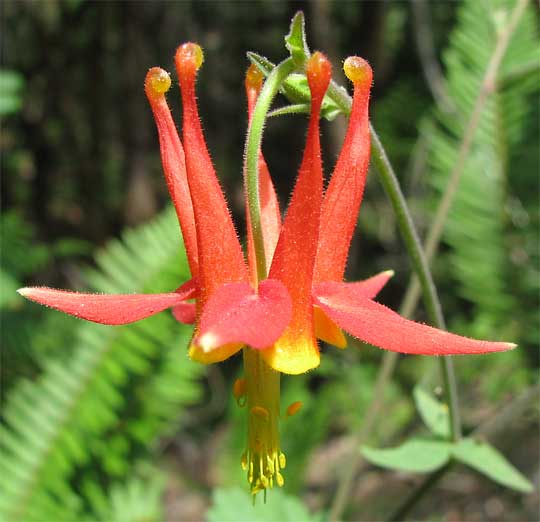Excerpts from Jim Conrad's
Naturalist Newsletter

from the the June 7, 2009 Newsletter, issued from the Siskiyou Mountains west of Grants Pass, Oregon:
COLUMBINES FLOWERING
Columbines here are similar to those ofn the East, though they're a different species. They're Western Columbines, AQUILEGIA FORMOSA, and you can see one along a mountain road, standing before a Swordfern, above.
Below, you see a single flower.
 Wildflower connoisseurs know that several blossom types bear petals equipped with hollow, nectar-secreting, backward-projecting spurs -- such as larkspurs, violets, touch-me-nots and nasturtiums. In the picture the slender, upward projecting, cone-shaped items are such spurs, well designed to entice nectar-searching hummingbirds, bees and butterflies. The actual flower petals associated with the spurs are much reduced, consisting of no more than the yellow projection at the base of each spur. The flower's horizontally spreading items, which at first we think might be petals, are actually the calyx's sepals doing the attention-catching job most flowers assign to their petals. Of course the downward-thrusting things looking like yellow-tipped matchsticks are the stamens.
Wildflower connoisseurs know that several blossom types bear petals equipped with hollow, nectar-secreting, backward-projecting spurs -- such as larkspurs, violets, touch-me-nots and nasturtiums. In the picture the slender, upward projecting, cone-shaped items are such spurs, well designed to entice nectar-searching hummingbirds, bees and butterflies. The actual flower petals associated with the spurs are much reduced, consisting of no more than the yellow projection at the base of each spur. The flower's horizontally spreading items, which at first we think might be petals, are actually the calyx's sepals doing the attention-catching job most flowers assign to their petals. Of course the downward-thrusting things looking like yellow-tipped matchsticks are the stamens.
In the common columbine of the East the flower's sepals project downward or at an angle instead of horizontally, plus they're shorter than the spurs, while you can see that our Western species' sepals are horizontal and about as long as the spurs.
Most columbines I've seen back East have been among mossy, rocky areas and in moist, protected valleys, but our Western Columbine shows up in relatively dry, weedy places, as well as moist, sheltered woodlands.